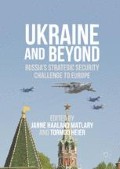Abstract
The present situation in Europe has raised concerns about whether the USA still has the will to provide security to European allies through extended deterrence.1 , 2 During the Cold War, countries within Moscow’s reach sought NATO membership solely for the “safe haven” of NATO’s article 5. Participation in international military operations was not the driving factor. The expense of NATO membership was merely a means to that end, seen as an investment in a security deposit one could draw upon in harder times. Few today envisage a US or NATO nuclear retaliation as a response to Russia’s interference in e.g. a Baltic country, as mentioned by Christopher Coker in Chap. 2 and discussed in some more depth by Julian Lindley-French in Chap. 6. However, nuclear weapons do frame any power-play involving NATO and Russia, and the issue of nuclear deterrence is still something to be reckoned with.
Access this chapter
Tax calculation will be finalised at checkout
Purchases are for personal use only
Bibliography
Anderson, Justin V., Jeffrey A. Larsen, and Polly M. Holdorf. 2013. Extended Deterrence and Allied Assurance: Key Concepts and Current Challenges for U.S. Policy (INSS Occasional Paper 69). Colorado: USAF Institute for National Security Studies, USAF Academy.
Buzan, Barry. 1987. An Introduction to Strategic Studies. Military Technology and International Relations. London: The Macmillan Press.
Daalder, Ivo H. 1991. The Nature and Practice of Flexible Response: NATO Strategy and Theatre Nuclear Forces Since 1967. New York: Columbia University Press.
Duffield, John S. 1995. Power Rules, The Evolution of NATO’s Conventional Force Posture. Stanford: Stanford University Press.
Facer, Roger L.L. 1985. Conventional Forces and the NATO Strategy of Flexible Response. Santa Monica: RAND Corporation.
Freedman, Lawrence. 2003. The Evolution of Nuclear Strategy. New York: Palgrave Macmillan.
Healey, Denis. 1961. A Conventional Alternative to Nuclear Retaliation: Turning Point for NATO. New Republic 144(17): 7.
Kugler, Richard L. 2003. Commitment to Purpose, How Alliance Partnership Won the Cold War. Santa Monica: RAND Corporation.
Mathers, Jennifer. 1998. A Fly in Outer Space; Soviet Ballistic Missile Defence during the Khrushchev Period. Journal of Strategic Studies 21(2): 31–59.
NATO Archives. 334/MC/300.6 (29th Session) Verbatim (incl. in Record MC/CS 29), General Taylor’s comments on MRBMs for NATO (Informal Session MC/CS, 11 December 1962).
NATO Archives. C-M (62)55, Statement by US Secretary McNamara on “Defence Policy”(5 May 1962).
NATO Archives. C-R (62)25, Summary Record (21 May 1962).
NATO Archives. IMSWM-64-68, Memorandum on “Revision of Facts about NATO” (5 March 1968).
NATO Archives. MC 100/1 (Draft), Appreciation of the Military Situation as it affects NATO up to 1970 (11 September 1963).
NATO Archives. MC 100: MC 100 (Mil Dec, incl. complete MC 100), The long term threat assessment (24 January 1963), and MC 100 (Final), The long term threat assessment’ (07 March 1963).
NATO Archives. Record MC/CS 30, Summary Record (Mountbatten to the Military Committee in Chiefs of Staff session), June 1963, (2 July 1963).
NATO Archives. SG 161/6, The Soviet Block Strength and Capabilities.
NATO Archives. SG 161/8, The Soviet Bloc Strength and Capabilities.
NATO Archives. SG 161/9, The Soviet Bloc Strength and Capabilities.
NATO Archives. SG 161/10, The Soviet Bloc Strength and Capabilities.
NATO Archives. SG 161/11, The Soviet Bloc Strength and Capabilities.
NATO Archives. SG 161/12, The Soviet Bloc Strength and Capabilities.
NATO Archives. SG 161/13, The Soviet Bloc Strength and Capabilities.
NATO Archives. SG 161/14, The Soviet Bloc Strength and Capabilities.
NATO Archives. SGM-517-63, Memorandum for the Standing Group Representative (27 November 1963).
NATO. C-M (56) 138 (Final), in Gregory W. Pedlow, NATO Strategy Documents 1949–1969.
NATO. MC 14/2 (Revised), in Gregory W. Pedlow, NATO Strategy Documents 1949–1969.
NATO. MC 48. Most Effective Patterns for NATO Military Strength for the Next Few Years, 18 November 1954, in Gregory W. Pedlow, NATO Strategy Documents 1949–1969.
Pedlow, Gregory W. 1997. NATO Strategy Documents 1949–1969. NATO Archive Web. Accessed March 1, 2006. http://www.nato.int/docu/stratdoc/eng/.
Podvig, Pavel, ed. 2004. Russian Strategic Nuclear Forces. Cambridge: MIT Press.
Sokolovskiy, Vladimir D. 1968. Soviet Military Strategy. 3rd ed. New York: Crane, Russak & Company.
Trauschweizer, Ingo. 2008. The Cold War US Army, Building Deterrence for Limited War. Lawrence: University Press of Kansas.
Author information
Authors and Affiliations
Editor information
Editors and Affiliations
Rights and permissions
Copyright information
© 2016 The Author(s)
About this chapter
Cite this chapter
Dyndal, G.L., Espenes, Ø. (2016). Deterrence and Limited Wars: Echoes from the Cold War?. In: Haaland Matlary, J., Heier, T. (eds) Ukraine and Beyond . Palgrave Macmillan, Cham. https://doi.org/10.1007/978-3-319-32530-9_4
Download citation
DOI: https://doi.org/10.1007/978-3-319-32530-9_4
Published:
Publisher Name: Palgrave Macmillan, Cham
Print ISBN: 978-3-319-32529-3
Online ISBN: 978-3-319-32530-9
eBook Packages: Political Science and International StudiesPolitical Science and International Studies (R0)

